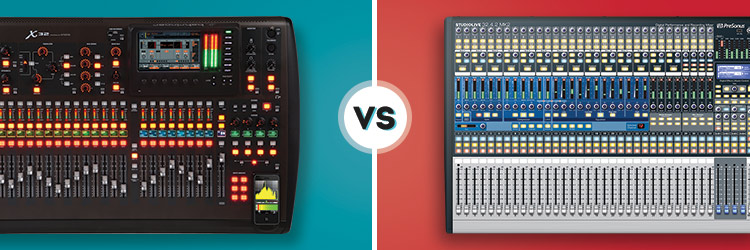I have a confession to make. I have said the words “Behringer” and “love” in the same sentence. And it’s a lot of love, actually. In the past, I have been one of those people who used to ridicule Behringer and its products for being cheaply made, with a terrible sound. Harsh I know. Through most of my career, I have avoided Behringer like the plague, until I tried their X32 Mixer. I’m so happy with the X32 and Behringer, that I compiled my top ten favorite things about this board and why you should try it out before dropping way more money on a PreSonus StudioLive mixer.
Behringer X32 Mixer VS Presonus StudioLive – 10 Reasons to Try Behringer Before Plunging for a Presonus Live
Recently my church had decided its time to upgrade our old Yamaha DM2000 soundboard to something a little more user-friendly. Not knowing where to turn, I reached out to my friend Chris at our local Guitar Center here in Lexington, who introduced me to the Behringer X32. I had been very familiar with the Presonus StudioLive line and had been considering the new 32 channel model as a replacement for our church. After about an hour going back and forth with Chris, my curiosity was sparked to the point where I figured I’d try the board. After all, I could always return it for the StudioLive if it didn’t work out.
It’s now been two months since we installed the Behringer X32 and I couldn’t be more happy with our decision. I’m so happy with the X32 and Behringer, that I compiled my top ten favorite things about this board:
1. Sound Quality – The Midas technology on this board is extremely apparent. The mic pre’s are quiet and powerful, I’ve never heard a Behringer board sound this clean!
2. Gain Sensitivity – Did I mention these mic pre’s are powerful? I’ve barely had to turn my gains past 11 o’clock for unity! These pre’s are definitely more powerful than the StudioLive pre’s. I remember being in situations using the StudioLive where I have all my gains maxed out, amps cranked, and I still needed more headroom. That won’t be a problem with the X32!
3. User Interface – One thing that was always difficult about the StudioLive was the concept of the “Fat Channel”. In my opinion, they overused that space and made navigating the board cumbersome. The X32 has a more traditional UI that uses a section for mix control and a separate section for operation control. It’s easy to use and quick to learn.

4. Savable Gain – The entire X32 is truly savable. From the gain structures to fader locations, to processing, everything saves! The PreSonus uses analog mic pre’s which means you either have to write down your gain settings every time you use the board or run a line check before every event. With the X32 I can walk into a room, load my settings, and as long as everything is patched correctly, be up and running immediately.
5. Motorized Faders – The X32 is one of the most inexpensive boards that has motorized faders. Once you have motorized faders, you’ll never go back. The StudioLive does offer a way to reset fader locations by using the meters on the FAT channel, but it’s not as efficient.
6. Cell Phone Holder – I know this sounds a little cheesy, but it is really convenient to have a spot to put my iPhone. I use it, all my techs use it, so hey, don’t knock it till you try it.
7. Omni Outs – I’ve seen this a lot on Yamaha’s soundboards but this is the first time I’ve seen Behringer adopt the Omni outs. The standard X32 has sixteen Omni outs without fifteen and sixteen configured as main outputs. The great thing about Omni outs is that they are assignable, so if I want my main house feed to be pumped to an overflow room, a live stream, and a CD burner it’s just a matter of assigning the out. The same Omni outs can be used for Aux outs to use as monitor mixes. Presonus gives you the ability to assign subgroups, but you only get four.
8. Channel Strip – I love that I can assign colors and labels to channels, I use it all the time. I also noticed that the channels have indicators that display level, clip, when the compressor kicks in, and when the gate turns on. The Presonus does provide the option to see input levels, but it again uses that FAT channel, which can be confusing to newbies and volunteers.
9. The P16 – Behringer makes an Aviom competitor called the P16. The P16 is a much cheaper and similar method of self-monitoring. At $250 per personal mixer, it’s hard to beat this method of in-ear monitoring when you already have the board in place. Since we switched our Aviom’s for P16’s none of our musicians have noticed a difference in quality. Its also really easy to assign the P16 channel list from the routing page on the X32. The Presonus doesn’t offer anything comparable.
10. And of course, the price – The X32 is much more affordable than the StudioLive 32.4.2. The X32 new is running around $2,800, while the Presonus comes in at a hefty $4,000. The next cheapest model in the Presonus line is the StudioLive 24.4.2, which still runs at about $3,000, $200 more than the X32 but only offers 24 channels!
I’ll be saying it more in the future, but man, I LOVE the Behringer X32! What’s your church currently using, what are its strengths and weaknesses? Let us know in the comments!
Check out our article that favors the PreSonus line here

